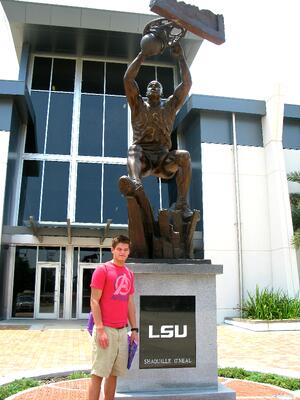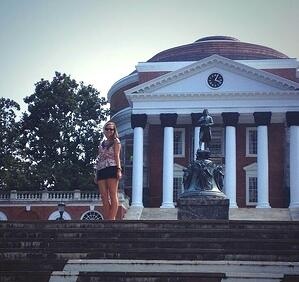 Springtime is around the corner. That means high school seniors are eagerly awaiting
Springtime is around the corner. That means high school seniors are eagerly awaiting
acceptance letters and juniors are in the home stretch for ACT and SAT prep. It also means that
with spring break on the horizon, and summer beyond that, now is a good time for all high school students to start planning those college visits. In this three part series, we’ll provide some guidelines and tips to make the most of your student’s college visits. We’ll start with an expert – a mom.
Terri Stuckey is no stranger to college visits. With a junior at Emory, a freshman at the University of Virginia and a junior in high school, she’s as close to an expert as they come. Stuckey has visited at least 26 schools, some of them twice, and she’s not done yet.
Start Local
Don’t let those numbers overwhelm you. Not all visits require airfare or lodgings or days away from school and work. One of the easiest places to start your journey is your local university. Even if your son or daughter is adamant about going away, this is a great place to begin. It doesn’t matter if they want to go to that particular school. Visiting different colleges lets students determine what they like and dislike. It’s just as important to take note of why they don’t want to go to a specific school.
These visits can be done on days off from school, after school or on a weekend. You can get a feel for the whole tour experience. This will help you gauge time for itineraries later if you decide to tour schools out-of-state.
In addition, attending local events on a college campus can give your son or daughter perspective and get them excited about the admission process. Catch a show put on by the theater department or cheer on the local team during a football game.
Vacations
If you’ve already planned your Spring Break vacation, find out if there’s a university near your destination. If you have the time, take a side-trip and schedule a tour. Have lunch or dinner on campus. Walk through and visit the bookstore or if you’re short on time, just drive through the university. Again, it’s a good starting point just to see what’s out there and to give them a point of comparison.
Just about every university my family visited was during a vacation. Road trips through the south brought us to the University of Alabama, Ole Miss, Tulane, LSU, Loyola, and the University of Miami. My boys are two years apart. I made sure the younger one was paying attention. Even their sister, five years younger, has fond memories of our campus visits.
Summer Camps
Stuckey also suggests enrolling your student in a weeklong, overnight, summer camp before going to the expense of scheduling out-of-state tours. Her kids did it the summer after their sophomore year in high school. “It doesn’t have to be where they want to go to college, but it’s a great way to see if they want to go away for school.”
It doesn’t necessarily have to be an academic camp. The point is to give them the experience of being on their own away from home, family and friends. It also provides them with the opportunity to live in a dorm. “Before you start looking at colleges all over the country, see if they can survive a week alone,” said Stuckey.
If they don’t enjoy the experience, then it helps narrow things down. It may not be worth it to visit universities more than a few hours away.
Many schools offer summer programs for high school students. It’s a great experience for the kids. Some offer guided tours as part of the camp, as well as meetings with admission and financial aid counselors. They may even offer college credit. Stuckey said being on campus gets them excited about going to school. “The kids also learn the vocabulary of admissions.”
It’s best to sign up as early as possible. Deadlines can be as early as March. Just search “college summer programs for high school students” and you’ll get a variety of listings. You can also check with your high school college counselors as they may have information about summer programs too.
Multiple Tours
Another option for visiting schools is to set up a group tour. Check with your high school to see if they offer any bus tours. Some may organize weeklong excursions visiting multiple schools within a specific region. “The kids see a variety of schools, but the parents aren’t with them,” said Stuckey. “The kids have fun, but they may not be looking at the things you, as a parent, want them to consider.”
There are also companies that coordinate tours of multiple universities in specific regions. This takes the hassle out of the planning and lets you concentrate on the school visits.
Stuckey said she never did more than four schools during one trip. “They start to blur in to each
other and it’s hard to keep straight.” She recommends taking lots of pictures, especially by specific landmarks and school signs so when you get back home they can help you remember the campus.
Virtual Tours and Social Media
Obviously, not everyone can afford the time or money to visit every school. Fortunately, the Internet and social media are great resources to learn about schools in the comfort of your own home. Every university has a website. Some offer virtual tours. You can also check out their Facebook page and mobile apps, as well as Twitter, YouTube and LinkedIn accounts. Students often post videos of school events, tours of dorms, etc., and many student groups have their own Facebook page.
“If they cannot physically tour the school, then it is extremely important that they read all that they can from different sources about the school,” said Charles Basden, Jr., coordinator, special projects, for George Washington University, a member of the NobleHour Network. “Many schools are developing virtual tours and online portals that seek to emulate the on campus tour feel. I would suggest creating a Google news alert for the schools they are interested in.”
In addition, Basden recommends reaching out to current students or faculty members through the directory or through student organizations to get a better sense of what campus life is about. Chatting with recent alumni can also provide a helpful perspective.
Photos by Dolly Duplantier
Next time - Part II - Deciding Where to Visit
Part III - Going on Tour – The College Visit: 15 Questions to Ask


 Springtime is around the corner. That means high school seniors are eagerly awaiting
Springtime is around the corner. That means high school seniors are eagerly awaiting




 If your student is always on the go and the thought of being home for four to five weeks will drive you both crazy, then consider a service trip to round out the winter break.
If your student is always on the go and the thought of being home for four to five weeks will drive you both crazy, then consider a service trip to round out the winter break.  The organization provides three simple meals, basic accommodations, and basic logistics to ensure a positive and productive experience. Volunteers must cover their own travel expenses and meals on days off. The organization has a strict minimum age policy and cannot accept volunteers under the age of 15 (14 in the Philippines). All 16 and 17 year olds must be accompanied with a responsible adult.
The organization provides three simple meals, basic accommodations, and basic logistics to ensure a positive and productive experience. Volunteers must cover their own travel expenses and meals on days off. The organization has a strict minimum age policy and cannot accept volunteers under the age of 15 (14 in the Philippines). All 16 and 17 year olds must be accompanied with a responsible adult. 




